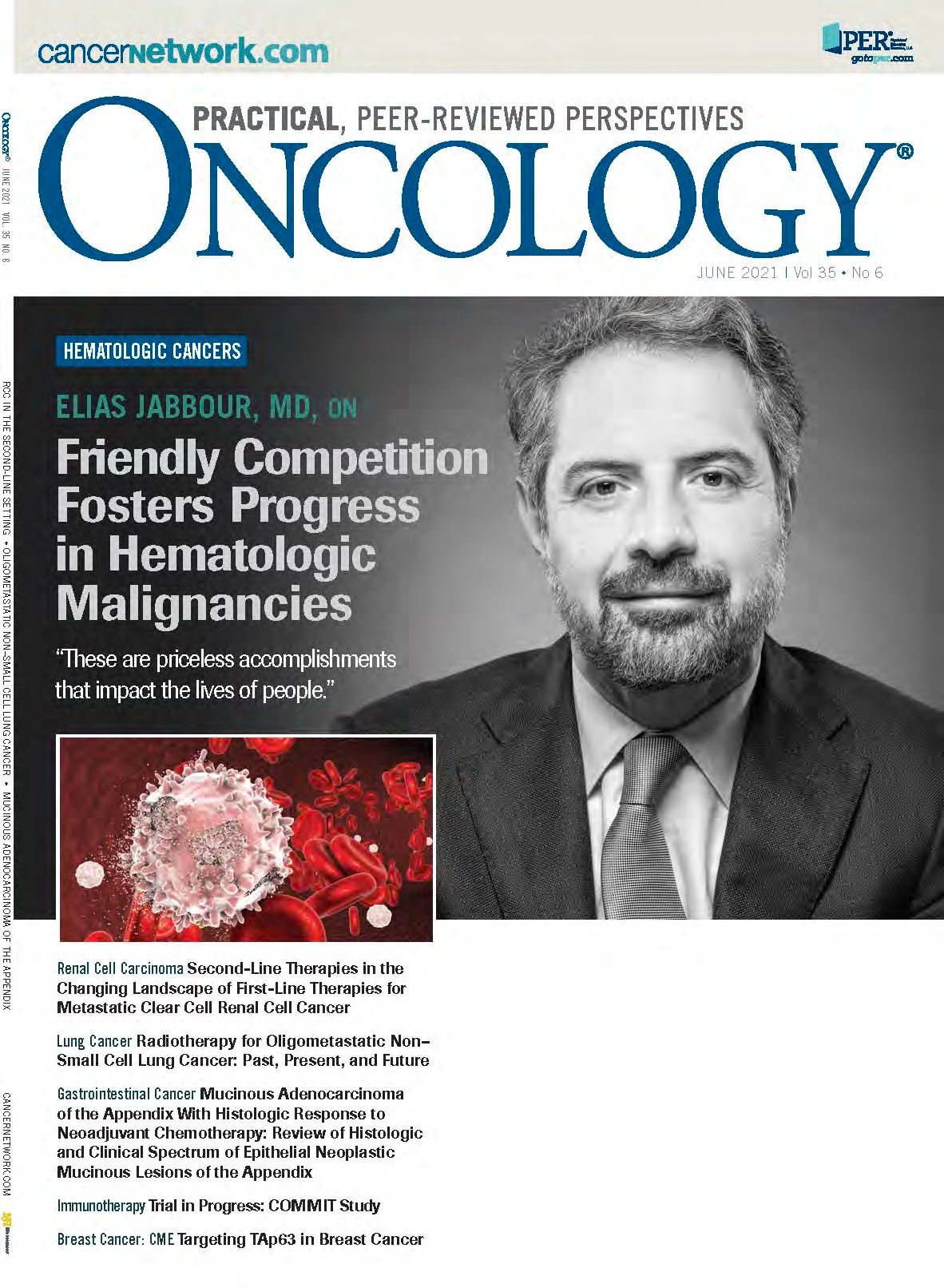Friendly Competition Fosters Progress in Hematologic Malignancies
“These are priceless accomplishments that impact the lives of people.”
Elias Jabbour, MD, is a professor of medicine in the Department of Leukemia, Division of Cancer Medicine, at The University of Texas MD Anderson Cancer Center in Houston, as well as cochair of the 5th Annual Live Medical Crossfire®: Hematologic Malignancies, hosted by Physicians’ Education Resource, LLC (PER®).

Treatment selection for patients with hematologic malignancies involves a vast knowledge of variations in biology and the rapidly evolving field of systemic therapy development. With options for transplant, chimeric antigen receptor (CAR) T-cell therapy, tyrosine kinase inhibitors (TKIs), and immunotherapy in most tumor types, appropriate therapy selection for a given patient is far from straightforward or standard.
To discuss this and emerging breakthroughs, Elias Jabbour, MD, a professor of medicine in the Department of Leukemia, Division of Cancer Medicine, at The University of Texas MD Anderson Cancer Center in Houston, reflected on his body of work and how competition among colleagues motivated his contributions to the field of medicine.
“I had an opportunity to work with giants in cancer. These are people who are heroes in treating cancer,” Jabbour said. “Working with them, you have to be at a level [where you] work hard and you have great competition to do the best you can.”
Continuing with the theme of friendly competition, Jabbour discussed the 5th Annual Live Medical Crossfire®: Hematologic Malignancies, hosted by Physicians’ Education Resource, LLC (PER®), to be held Saturday, July 17, 2021, for which he is the cochair. The annual event considers emerging topics by presenting contrasting viewpoints of key opinion leaders across a broad range of hematologic malignancies. By exploring the issues from different perspectives, clinicians may be better equipped to treat a wide range of patients.
“With leukemias and hematology [in general], these are rare diseases compared with solid tumors. People who treat hematologic malignancies have a major interest in the field,” he said. “Leukemia, in particular, is really evolving at a very high speed. Every year, we see new therapies [and] a new standard of care. It’s hard to keep pace with the evolution…these are priceless accomplishments that impact the lives of people.”
In preparation for the meeting, Jabbour sat down with ONCOLOGY® to discuss emerging trends in leukemias, his area of specialty.
Q: Can you speak to some of the recent advancements in the treatment of acute lymphocytic leukemia (ALL)?
About 6000 patients [present with ALL] per year in the United States—roughly half are pediatric, and half are adult. [In children], outcomes are outstanding, with survival around 90% and above. In adult patients, outcomes are less favorable. At the 1-year [mark], survival is about 60% at MD Anderson, which is quite good compared with [what it was] 10 and 15 years ago, but we’re still far away from [the survival rate seen with] pediatric ALL.
However, we have the tools to cure this disease. Why am I saying this with confidence? For
2 reasons: First, we have a better understanding of the biology of ALL, and therefore, we’re able to tailor our therapy strategy based on biology. Second, we have new drugs that, after being tested, have shown promising results.
I’ll give an example: TKIs in stage IV ALL. These are really potent drugs, and when combined with chemotherapy and immunotherapy, you can have great results. [We can see] a 5-year survival rate of 76%, negating the need for transplant or intensive approach. We have monoclonal antibodies, among them the CD20 antibody rituximab [Rituxan]; this, when combined with chemotherapy, improves outcome. We have bispecific engagers like blinatumomab [Blincyto], effective in the relapsed setting and the minimal residual disease [MRD] setting. And we have an antibody-drug conjugate against CD22, inotuzumab ozogamicin [Besponsa], and this drug is available today for the refractory setting. [Plus], ongoing trials using a combination of chemotherapy with inotuzumab and blinatumomab are showing very promising results. And these drugs are moving to the fourth line.
Then we have CAR T-cell therapy, which is [among] the great innovations in science right now. I see the role of CAR T[-cell therapy] possibly replacing transplant and being a conservative approach post chemotherapy [or following] inotuzumab or blinatumomab.
And finally, [among] the most important things to [continue looking at] in ALL is assessment for MRD. Data [indicate that] this is the principle of therapy, and it’s why I’m confident we’ll make progress in the next 10 to 15 years.
All patients with ALL used to have very poor outcomes because of the aggressive [nature of the] disease and, in older patients, poor tolerance to chemotherapy using normal drugs in the fronline like inotuzumab and blinatumomab. We have made huge progress, and survival has gone from 20% to 50%. In young adults, using the pediatric regimen or hyper-CVAD [cyclophosphamide, vincristine sulfate, doxorubicin hydrochloride, and dexamethasone], we have a survival rate of 70% [at 5 years]. We did great.
These are all the principles and they’re evolving. We don’t have [one-size-fits-all] therapy that is good for everyone, but I think the future is to [treat] according to biology and to move away from intensive chemotherapy; [we’ll go] to more of an approach that can improve the outcome without inducing a lot of toxicities.
Q: Is a chemotherapy-free treatment approach the future of ALL treatment, broadly speaking?
This is what we’re aiming to accomplish, but whether we succeed or not remains to be seen.
One of the most exciting things in ALL, essentially, is to be able to stop therapy. We’re able to define short-term therapy based on response. For example, if we can assess for MRD with a very sophisticated technique and identify true responders, then these patients will be spared the need for intensive chemotherapy or prolonged therapy.
Q: Can you speak to some of the recent research and strategies in the treatment of chronic myeloid leukemia (CML)?
My work in CML is [about] how we can stop therapy. [First] is novel drugs: I think there’s still room for novel, potent drugs that are safer than what we had before. [Second] is how we can increase the proportion of patients who can stop therapy and remain free of relapse. And by that I mean whether we should stick only to TKIs or explore the combination of TKIs with other drugs, such as BCL2 inhibitors.
Q: The acute myeloid leukemia (AML) landscape is exciting, with so much work going on the past few years regarding new targets and new agents. What are your goals in AML, and what do patients need now?
I’m fascinated by the role of BCL2 inhibitors in AML. Already, we have a new standard of care and the question is whether we can cure more younger patients. Are we testing combination chemotherapy plus BCL2 inhibitors? It seems that the cure rate is really improving at a very high speed, which is quite good. Of course, the subset of patients with [traditionally poor outcomes] urgently need new drugs.
We already have a standard of care, which is a combination of hypomethylating agents with BCL2 inhibitors. That is a starter, and [we need to determine] whether we can build on it by adding further targeted therapy for the improved outcomes. That is yet to be defined, but several trials are ongoing.
Financial Disclosure: The authors have no significant financial interest in or other relationship with the manufacturer of any product or provider of any service mentioned in this article.

Newsletter
Stay up to date on recent advances in the multidisciplinary approach to cancer.